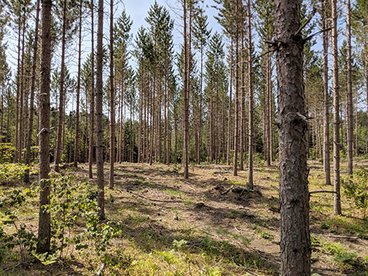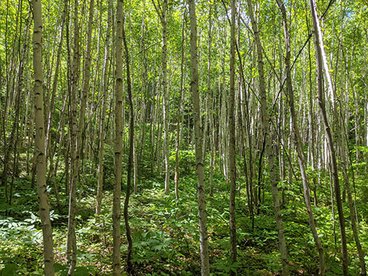Located in the Lake Superior watershed at the southern edge of the boreal forest, the CFC consists of 3,471 acres of intensively, extensively, and/or passively managed forest. We recognize that all individual portions of the forest, most often called “stands”, cannot support every forest management objective. Instead, we employ a diversified management approach that follows the Landscape Triad conceptual framework (see Seymour and Hunter 1992 and Gilmore and Palik 2005 for more details) so that the broader forest landbase can support our wide range of objectives.
The bulk of the CFC (3,391 acres) is located near Cloquet, MN with much of the forest growing on sandy outwash plain soils. Local climate is moderated by Lake Superior resulting in relatively cool and wet growing seasons when compared to other portions of Minnesota. The growing season length is rather short, spanning mid-May to mid-September. CFC’s forests are sub-boreal in composition with roughly two-thirds in upland and one-third in lowland positions. A majority of the upland forests are dominated by red pine, jack pine, paper birch, and trembling aspen (MN DNR Native Plant Communities; FDn32, FDn33, and FDn43). The lowlands are primarily dominated by black spruce and tamarack lowland forests (APn80, APn81, FPn62, and FPn63) and a small amount of white cedar and black ash wet forests (WFn55 and WFn64). To learn more about CFC history, ecology, and our ecologically-based forest management goals, objectives, and proposed harvesting actions please consult the current forest management plan.
The CFC, the Hubachek Wilderness Research Center (HWRC), the Allred Trust, and the Boone Trust properties make up the entire network of experimental forests that we manage for the purposes of natural resources research and education. The Hubachek Wilderness Research Center (365 acres), adjacent to the Boundary Waters Canoe Area Wilderness near Ely, MN, supports a variety of boreal forest communities (primarily FDn43 and FPn62) on shallow soils over ledge rock. The Allred Trust (160 acres) forest, near the northernmost bay of Lake Vermilion, is primarily covered by a young aspen-birch expression of an FDn43 native plant community over Myrtle Lake Till Plain soils. The Boone Trust (200 acres) contains northern hardwoods communities (primarily MHn35) over rich morainal features on the Iron Range near Thunderbird Lake, south of Hibbing. All of these properties are managed with respect to the University of Minnesota and CFC missions and ecologically-based forest management principles detailed in the CFC forest management plan.
If you are interested in initiating research at the CFC, HWRC, Allred, or Boone forests or have other questions related to our research and ecosystem stewardship, please contact Kyle Gill.
How We Manage Our Forests
Active forest management is critical to meeting all components of our mission. Forest management at CFC is guided by a 10-year Forest Management Plan with harvests that are carried out to meet research, education, and outreach objectives. As an example, the Stand 57 harvest and followup treatments prescription was developed to promote structural and compositional diversification to encourage forest community resilience to expected changes in climate patterns over the next 50-100 years. “Active forest management” is generally considered to be managed for commercial timber production objectives. However, we have areas that are also actively managed for non-timber objectives such as wildlife habitat.
The CFC has around 200 acres of forests in red pine, birch, and cedar cover-types reserved from active management. These are considered to be under “Passive Management” because they are monitored, are a part of the overall forest management portfolio, and may receive some preventative treatments, such as fuels-reduction, to promote forest health and function. Some of these unique stands contain fire-origin red pine cohorts approaching 200 years old with scattered red pine in excess of 300 years old. Additionally, there are numerous long-term research stands reserved from active management treatments.
Forest Management Plan 2016-2025
Report on 2016 forest harvest activities
Historical Management Plans or Management Reports:
- Cloquet Forestry Center Forest Management Plan 2002-2011
- Cloquet Forestry Center Forest Management Plan 1992-2001
- Cloquet Forestry Center Forest Management Report (1981-1986)
- Management of the Cloquet forest: second ten-year period (1946)
- The Cloquet Forest: a demonstration of practical forestry in northern Minnesota (1935)
- Report of Cloquet Forest Experiment Station (1917)


